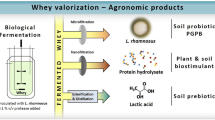Abstract
The All-Russia Research Institute of Reclaimed Lands has a long and fruitful history in development of biofertilizers and multifunctional biopreparations using directed bioconversion. This paper describes innovative elements of a fundamentally new technology for the production of a promising biofertilizer. The development of a new algorithm for bioconversion of peat–manure mixes is required for production of a competitive biofertilizer characterized by favorable acidity and a high content of beneficial microorganisms and bioavailable nutrients as well as for the choice of the most efficient bioconversion process. Three processes differing in their parameters have been compared in three repetitions via evaluation of the content of ammonifying and amylolytic microorganisms, sanitary microflora (enterobacteria), fungi, and actinomycetes in the initial peat–manure mixes and final products (variants of new biofertilizers); additionally, the activity of oxidoreductases and some agrochemical parameters have been compared. The algorithm of a fermentation process includes acid hydrolysis of the initial mix and two thermal stages. At the first stage (55–60°С for 24 h), the required ecological compatibility of a biofertilizer, characterized by the minimum presence of a sanitary microflora and spoilage fungi, is achieved. The second stage (36–39°С for 96 h) is characterized by an active development of microflora involved in the formation of the soil structure and fertility. In the course of the study, the optimum fermentation variant characterized by the maximum content of beneficial microflora, minimum content of enterobacteria, and a high content of key nutrients required for the plant growth (nitrogen, phosphorus, potassium) has been chosen.

Similar content being viewed by others
REFERENCES
Galynskaya, N., Biological products for the protection of plants from diseases and pests. http://kvetky.net/2012/biopreparaty/.
Ivanov, A.A., Matrosova, L.E., and Tremasov, M.Ya., Production and use of biofertilizer based on poultry droppings, Russ. Agric. Sci., 2013, vol. 39, nos. 5–6, pp. 471–473.
Ryakhovskaya, N.I., Gainatulina, V.V., Shalagina, N.M., Shiyan, V.I., Makarova, M.A., and Arguneeva, N.Yu., Innovative technology for obtaining compost and its use in the cultivation of potatoes, Plodorodie, 2012, no. 5, pp. 31–34.
Novikov, M.N., Khokhlov, V.I., and Ryabkov, V.V., Ptichii pomet—tsennoe organicheskoe udobrenie (Poultry droppings: Valuable Organic Fertilizer), Moscow: Rosagropromizdat, 1989.
Kiseleva, N.I., Zharikov, G.A., Galkina, N.N., Kolombet, L.V., Borovik, R.V., and Dyadishchev, N.R., RF Patent 2125549, 1999.
Pavlova, L.N., Samogin, S.K., Rozenko, G.T., Kalinin, E.K., and Il’mer, E.I., RF Patent 2092470, 1997.
Belyuchenko, I.S., Gukalov, V.V., and Slavgorodskaya, D.A., RF Patent 2529174, Byull., 2014, no. 27.
Naumovich, V.M., Torfyanye resursy na sluzhbe sel’skogo khozyaistva (Peat Resources in the Service of Agriculture), Moscow: Nedra, 1991.
Teoreticheskoe obosnovanie tekhnologii biologizatsii zemledeliya (Theoretical Substantiation of Biologization Technologies in Agriculture), Es’kov, A.I., Ed., Moscow: Rossel’ khozakademiya, 2005.
Chen, Z. and Jiang, X., Microbiological safety of chicken litter or chicken litter-based organic fertilizers: A review, Agriculture, 2014, vol. 4, no. 1, pp. 1–29.
Golabi, M.H., Denney, M.J., and Iyekar, C., Value of composted organic wastes as an alternative to synthetic fertilizers for soil quality improvement and increased yield, Compost Sci. Util., 2007, vol. 15, no. 4, pp. 267–271.
Hanc, A., Tlustos, P., Szákova, J., Habart, J., and Gondek, K., Direct and subsequent effect of compost and poultry manure on the bioavailability of cadmium and copper and their uptake by oat biomass, Plant Soil Environ., 2018, vol. 54, no. 7, pp. 271–278.
Tumanov, I.P., Malinin, B.M., and Kovalev, N.G., RF Patent 2141464, 1999.
Rabinovich, G.Yu., Fomicheva, N.V., and Smirnova, Yu.D., RF Patent 71654, Byull., 2008, no. 8.
Fomicheva, N.V. and Rabinovich, G.Yu., RF Patent 2520144, Byull., 2014, no. 17.
Rabinovich, G.Yu., Nauchnye osnovy, opyt prodvizheniya i perspektivy biotekhnologicheskikh razrabotok: Monografiya (Scientific Fundamentals, Promotion Experience, and Prospects for Biotechnological Developments: Monograph), Tver: Tver. Gos. Univ., 2016.
Rabinovich, G.Yu. and Tikhomirova, D.V., RF Patent 2539781, Byull., 2015, no. 3.
Author information
Authors and Affiliations
Corresponding author
Ethics declarations
The authors declare that they have no conflict of interest. This article does not contain any studies involving animals or human participants performed by any of the authors.
Additional information
Translated by N. Statsyuk
About this article
Cite this article
Rabinovich, G.Y. Development of a New Algorithm for Production of a Highly Efficient Biofertilizer From Peat–Manure Mixes. Russ. Agricult. Sci. 45, 539–542 (2019). https://doi.org/10.3103/S1068367419060193
Received:
Revised:
Accepted:
Published:
Issue Date:
DOI: https://doi.org/10.3103/S1068367419060193




